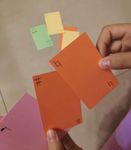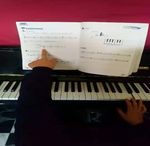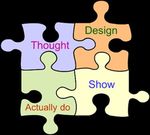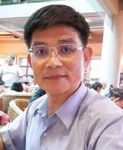The Study on Flexible Music Teaching Method of Innovative Poker Design
←
→
Page content transcription
If your browser does not render page correctly, please read the page content below
International Journal of Learning and Teaching Vol. 7, No. 2, June 2021
The Study on Flexible Music Teaching Method of
Innovative Poker Design
Teng-Chiao Lin1, Hsing-Hui Chen2, Wei-Chang Yang2, Shao-Shiun Chang 2, Yu-Lin Yang3, Shinn-Dar Wu4
and Yen-Chin Chang5
1
Graduate Institute of Technological & Vocational Education, National Taipei University of Technology, Taipei City,
Taiwan
2
Department of Industrial Education and Technology, National Changhua University of Education, Changhua City,
Taiwan
3
Institute of Innovation Technology and Information Management, National Chin Yi University of Technology,
Taichung City, Taiwan
4
Advanced Green Industrial Technology Research and Certification Center, National Cheng Kung University, Tainan
City, Taiwan
5
University of Music and Performing Arts, Mannheim, German
Email: {wutom123, hsinghui1222}@gmail.com
Abstract—From ancient times to the present, music allows listening and singing. In the beginning, I learned from
people to listen to music from different periods, understand imitation, heard a tone, scale or melody, and then imitated
its structure and expressions, perceive which nationality, these sounds. The basic requirement is that you need to
region, age, and type of music, and then express its thinking sing intonation and rhythm. The singing process can make
at that time. The unique feeling of music creation is
purposeful and connotative, which implies the author's life
you feel the feeling, shape and texture brought by this
experience and thoughts, and can bring people beautiful music language. Listening and singing is the most
enjoyment and express people's emotions. From the growth effective tool for learning music, because the process of
of learning, music plays an important role and is an receiving a sound from the ear to imitate singing needs to
important part of primary education. It is an effective tool be processed and absorbed by the brain, so learning music
for cultivating children's artistic literacy. Generally, music is the most direct method [1]. Here, we argue that this
education in kindergartens has begun around the world. In
ancient China, music was regarded as one of the six artistic
experience‐ dependent plasticity occurs because of the
abilities that scholars and scholars should possess. As for the multisensory nature of the brain and may be an important
formal music education in China, it continues until the end of contributing factor to musical learning. Steven Brown and
nine years of compulsory education, that is, graduation from Joseph Jordania (2011) research pointed out that, the
junior high school. At present, music education is also origin of music is based on the assumption of human
offered in ordinary high schools. This study found that
"invention". [2] Music creation is considered to be spread
learners can sing, express emotions and have a happy time
with music. Afterwards, the music melody gives the listener to other cultures through communication. Today, it is
motivation, comfort and peace, but from beginning to end, becoming more and more obvious that music has very
learners often only envy and cannot play. The reason can be far-reaching evolutionary roots [3], and at least some of
summarized as a bunch of musical pokers such as "sprouts", the most important similarities found in music are the
during the period of enlightenment, especially in elementary fusion of musical elements around the world [4]. Research
school. After the learner recognizes the musical poker, it
by Jian Zixin and others pointed out that music training
cannot be connected with the Sheet music, resulting in a
great sense of distance in the recognition of notes, beats, and based on vocal practice and tone awareness can help
melody. Therefore, this study introduces innovative thinking children with hearing impairment to achieve the effect of
courses combined with music education, which mainly tone clarity in Mandarin [5]. The results of the
discusses the training of sound sense and beat, and uses comprehensive study found that: (1) data analysis based
cross-field teaching to make musical pokers no longer on the auditory perception score of the human ear, vocal
unfamiliar.
practice and tone awareness-based music training have an
Index Terms — Innovative teaching, musical pokers,
immediate effect on the performance of Mandarin tone
gaming experience intelligibility in children with hearing impairment; (2)
Through computer voice acoustic analysis, after the
I. INTRODUCTION intervention of music training for the three-bit
hearing-impaired children, the tone length, fundamental
Learning music doesn't have to start with musical
pitch and curve mode of the Mandarin language have all
instruments. The easiest and most direct is to learn from
improved significantly; (3) After the end of the
Manuscript received January 1, 2021; revised April 27, 2021. experimental teaching intervention, the two-week
© 2021 International Journal of Learning and Teaching 68
doi: 10.18178/ijlt.7.2.68-72International Journal of Learning and Teaching Vol. 7, No. 2, June 2021
follow-up was continued during the retention phase. The composed of keys, scores, and metronome; the metronome
performance of the Mandarin tone intelligibility of the swings to learn the beat, and the beat learns the
three hearing-impaired children all had significant characteristics of the notes and other related learning.
retention results. When the three items are carried out at the same time, the
Therefore, first of all, from the interaction of learners changes of ear-listening metronome sound, eye reading
and educators, we will introduce innovative instructional spectrum and keys, and eye and brain response piano
design (Fig. 1). Introduce innovative elements into design spectrum often make learners easily flinch. In general, in
thinking, and effectively guide learning "pokers" through order to make notes and beats have more experience, we
the process of thought, design, implementation, and will beat the beats by hand, etc. for slow training.
presentation, and introduce the core of learning quality
B. Course Design
through innovative education [6]. This is a simple
supplement to the core literacy of various disciplines, but The method we use is to promote happy learning, so that
also the accumulation and enrichment of everyone has an equal educational space, so that students
cross-disciplinary literacy in various disciplines [7]. from different classes and different families can enjoy the
Secondly, teachers are required to establish an educational fun of learning. Therefore, we propose a teaching method
idea of "knowledge education" instead of "knowledge of "playing fun notes, playing music, and playing with
education", and pay attention to the process of creativity", as shown in Fig. 3 [9].
transforming knowledge into subject quality and ability.
Furthermore, from "teacher center" to "student center",
that is to improve students' learning enthusiasm is to
change the teaching center from "teaching" to "learning".
Teachers should stimulate students' interest in learning
and guide students to learn independently, forming the
ability to think independently, practice and lifelong
learning [8], [9].
Figure 3. Get ready [9].
Traditional teaching methods, beat teaching, usually
clap hands, beat the board and use the metronome to
increase students' understanding of music and learn the
changes in notes. In this multi-learning process, we have
added activity designs, such as: iPad media interaction,
line-line grid jumping, learning expression, and
board-shaped learning notes and chess, to allow music to
Figure 1. Four steps of innovative thinking [9]. add different interactive modes. It is very important to
guide beginners and slow learners.
C. Experiential Interaction
II. TEACHING DESIGN
First of all, we will use the four ideas shown in Fig. 1 to
A. Learning of Musical Notes understand the difficulties and problems of learning notes
in different age groups; Entering the first stage of thinking
and summarizing, we chose 1 to design the interactive
mode. In this report, the study of slow learners is used as a
case design discussion. The second stage design of the
musical poker is shown in Fig. 4. The poker (board game)
design allows learners to experience situations such as
notes, symbols, and beats.
The third stage consists of Fig. 4. The Poker allows
learners to experience different acti vities, such as: Use
poker to learn to listen to the rhythm of sound, note
solitaire learning observation, math game of note beat plus
music, note heart disease learning response A variety of
Figure 2. Piano keys, sheet music and metronome.
situational games, the fourth stage is to allow learners to
In the traditional note teaching as shown in Fig. 2, it is experience.
© 2021 International Journal of Learning and Teaching 69International Journal of Learning and Teaching Vol. 7, No. 2, June 2021
In this teaching, not only see the learner's learning
motivation, but also see the interactive discussion between
the learner and their parents. Although traditional learners
have active, passive, passive plus forced, etc., which often
cause the haze of music, this note-book interaction not
only changes the teaching method, but also increases the
fun of learning. Therefore, in addition to the musical note
book, we also designed many interactive textbooks, so that
we can perform various advanced changes such as piano,
spin, and percussion.
Figure 4. Musical poker. (Developing Teaching Aid)
III. EXPERIENTIAL TEACHING
After actually letting the learner experience the musical
poker, not only can the learner be allowed to train after
school, but also one of the teaching aids that is helpful for
the teacher to guide the beginner. Taking piano learners as
an example, students increase the fun of piano learning
after game interaction, as shown in Fig. 5-Fig. 6.
Figure 7. Musical poker.
The experimental musical poker test results shown in
Fig. 6 allow children to have a new experience of
cognition. This time, the primary school first and second
grades are used as the learning-oriented design. As shown
in Fig. 7, learning cognition includes: symbols, beats,
colors, let children Combining the mathematical addition
and subtraction of the course, from Fig. 7 musical poker,
to Fig. 8 musical poker note solitaire game, using the
traditional poker game principle, adapted to the note
solitaire math mode, with notes, beats, colors, let the
children combine the course comprehensive learning In
order to achieve one of the objectives of the course,
students will be able to exclude problem solving and
Figure 5. Experience learning results. digital obstacles in the symbol, and the game experience
will allow children to break through the new knowledge
learning obstacles and self-confidence problems, and the
preliminary children’s learning results will reach
expectations. Music can cultivate the mind; the purpose of
music education is to cultivate a good personality by
improving people's musical literacy. Some people say that
music is language, music is mathematics, and music is art.
Others say that the essence of music is science, the
purpose of music is education, the performance of music is
art, and the content of music is philosophy. The proportion
of music in human culture, history, and life is
unquestionable. Music is the art of time, and teaching
itself is an art. The teaching of music can be very diverse,
without being very boring or out of reach. With the
innovative teaching method of musical poker in this
research, we are not just leading students into The great
music hall also let them see the music that has not declined
Figure 6. Actual learning diagram. for hundreds of years. In the future, more courses and
© 2021 International Journal of Learning and Teaching 70International Journal of Learning and Teaching Vol. 7, No. 2, June 2021
games will be designed, with the goal of multi-learning, In the actual teaching, the first trial teaching in the 1st
arousing the students' desire to learn, so that children can and 2nd grades of "Jiadong Elementary School", the
become a short time Recognize the master. classroom situation of the innovative music card is shown
in Fig. 9 and Fig. 10, see the interactive experience of
students. In the future, the teaching and testing will be
carried out with children in the same class. In order to
achieve the learning effect, more follow-up discussions
will be possible in the future.
IV. CONCLUSION
Introducing music teaching in innovative thinking, the
musical poker not only increases the liveliness, but also
aims at the distance of students in the learning process. In
this method of innovative thinking, you can write many
practical processes according to actual needs. Any element
related to it, such as: learning notes, scale changes, sound
distance, etc., are oriented to change. Although music can
Figure 8. Musical poker note solitaire game. make people happy and happy, most people want to
understand in depth, but because of the recognition of
notes, there is a great distance. Therefore, this study learns
music with pleasure, and can also simply explain the
innovative note elements and original intentions in the
corresponding ideas. From the development of innovation,
invention and guidance to the cultivation of musical
cultural characteristics, the tutor must have a broad mind
to guide students to gradually realize more innovation and
creativity and move towards the future.
The derivation of this music cognition research includes:
the building of children’s self-confidence, the
breakthrough of new knowledge, and the exploration of
new knowledge. The curriculum is also combined with
other courses. It is also a change in the new syllabus of
Figure 9. Teaching situation Taiwan. Therefore, it will be tracked and improved in the
future, so that education has new conformity to the present
the diversity of society is also an important item for future
research.
CONFLICT OF INTEREST
This paper is a cross-disciplinary teamwork and was
published in this rigorous academic, so this paper "The
author declares no conflict of interest".
AUTHOR CONTRIBUTIONS
The contribution of each author to this research work is
described as follows:
Teng-Chiao Lin, Hsing-Hui Chen, Wei-Chang Yang,
Shao-Shiun Chang, And Shinn-Dar Wu jointly discussed
innovative teaching research methods and implementation
of teaching method design.
Hsing-Hui Chen, Yu-Lin Yang, Shinn-Dar Wu, and
Yen-Chin Chang, for the design of music cards.
Doctoral candidate Hsing-Hui Chen and Wei-Chang
Yang drafted the first edition of the article, which was
discussed and the future development of teaching by
Professors Teng-Chiao Lin, Shao-Shiun Chang and And
Figure 10. Happy learning for students Shinn-Dar Wu. The actual teaching Hsing-Hui Chen,
© 2021 International Journal of Learning and Teaching 71International Journal of Learning and Teaching Vol. 7, No. 2, June 2021
Yu-Lin Yang, Shinn-Dar Wu and discussion and revision, Wei-Chang Yang. He is the doctoral students
at the Department of Industrial Education and
all authors approved the final version. Technology at National Changhua University
of Education, Taiwan.
ACKNOWLEDGMENT Doctoral research, current research related to
majors: innovative education, flipped
Thanks to "Jiadong Elementary School, Hsinchu, education and experiential education.
Taiwan" for providing demonstration teaching to students
in grades 1 and 2 so that we can achieve good results in the
first stage of innovative teaching methods and literacy
education. In the future, we can have a good follow-up in Chang Professor at the Department of
the demonstration teaching every semester, Special thanks Industrial Education and Technology at
National Changhua University of Education,
to. Taiwan. His current research is in the
mechatronics, statistics, education, Artificial
REFERENCES intelligence, machine learning, finance and
engineering education.
[1] E. Zimmerman and A. Lahav, “The multisensory brain and its
ability to learn music,” Annals of the New York Academy of
Sciences, vol. 1252, no. 1, pp. 179-184, 2012.
[2] B. R. O. W. N. Steven and J. Jordania, “Universals in the world's
musics,” Psychology of Music, 2011.
[3] S. Mithen, I. Morley, A. Wray, M. Tallerman, and C. Gamble, “The Yang Yulin, R&D director, born in Miaoli,
singing neanderthals: The origins of music, language, mind and Taiwan, and graduated from Qinyi University
body, by steven mithen,” Cambridge Archaeological Journal, vol. of Technology with a master's degree in
16, no. 1, pp. 97-112, 2006. industry. Majors: Innovative education,
[4] J. Morgan, What’s the Difference between Invention and Innovation, chemical engineering, energy and reuse
September 10, 2015. technology.
[5] T. H. Chien and S. Y. Chen, “The effect of music training on Yang R&D Director is currently the R&D
mandarin tone intelligibility for children with hearing Director of Carbon Green Energy Technology
impairments,” Bulletin of Special Education, vol. 32, no. 2, pp. Co., Ltd., currently engaged in innovation
93-114, 2007. education, technical support, and new material
[6] T. Chernyshova, A. Prokopev, D. Bobin, and E. Babeshkova, research and development.
“Formation of innovative potential of students,” in New Silk Road:
Business Cooperation and Prospective of Economic Development,
March 2020, pp. 687-691. (Atlantis Press).
Professor Wu Shinn-Dar Ph.D., born in
[7] S. Maranville, “Entrepreneurship in the business curriculum,”
Hsinchu, Taiwan, and graduated with a PhD in
Journal of Education for Business, vol. 68, no. 1, pp. 27-31, 1992.
Mechanical Engineering from National Chiao
[8] P. Frankelius, “Questioning two myths in innovation literature,”
Tung University. Majors: innovation education,
The Journal of High Technology Management Research, vol. 20,
machinery, materials, energy and reuse
no. 1, pp. 40-51, 2009.
technology.
[9] Y. H. Shan, W. X. Jiang, S. D. Wu, P. W. Tsai, W. N. Chai, Y. L.
Corresponding author e-mail:
Yang, and Y. C. Lin, “The study of the new innovative education in
wutom123@gmail.com
the self-study group,” in Proc. 1ST Society of Innovative Education
Professor Wu is currently a professor at Green
and Technology, 2019.
Energy Research Center of Saint Paul’s
College & DePaul University and researcher at Advanced Green
Copyright © 2021 by the authors. This is an open access article
Industrial Technology Research and Certification Center of National
distributed under the Creative Commons Attribution License (CC Cheng Kung University and Director of Renewable Energy Material
BY-NC-ND 4.0), which permits use, distribution and reproduction in any Technology Research Institute of Taiwan Development Institute. He has
medium, provided that the article is properly cited, the use is invention, science and education awards and competitions totaled 23
non-commercial and no modifications or adaptations are made. Gold, 25 Silver, 5 Bronze and 13 special prizes (Statistical time
2007-2020). Professor Wu is Main research
Teng-Chiao Lin. He is an associate professor 1. Energy Storage Technology: Lithium Battery, Fuel Cell, Lead Battery
at the Department of Graduate Institute of 2. Reuse Technology: Agricultural Waste, Building and Ceramic Waste,
Technological & Vocational Education at the Plant Carbonization Technology
National Taipei University of Technology. 3. Science and Technology Integration: Ecological and Circulatory
His current researches focus on educational agriculture, Green Energy Integration System, Circular Economy,
policy analysis, educational administration, Carbon Rights Trading, Patent Layout, Innovation and Invention and
vocational education, industry-univeristy Education, Imitation ecological agriculture and fishery system
cooperation, basic education, information 4. Industrial Support: Industrial Technology Upgrading and
education, sports policy and practice. Technological Transition
Yen-Chin Chang. She is a master student at
Hsing-Hui Chen. She is the doctoral students the State University of Music and Performing
at the Department of Industrial Education and Arts Mannheim, Germany.
Technology at National Changhua University Current research related to majors: music
of Education, Taiwan. education and experience education, and
Doctoral research, current research related to interactive learning with teaching.
majors: innovative education, flipped
education and experiential education.
© 2021 International Journal of Learning and Teaching 72You can also read



























































